10 Most Famous Spring Paintings
The four seasons of the twelvemonth take long served as focal points for artists who sought to portray the emotions and feelings that each one brings to nigh people.
Jump is a flavor that is inundation with life and new beginnings.
Summer is total of action or lounging near while fall is chock with vibrant colors and wintertime typically represents an ending or loneliness.
Artists have found considerable amounts of inspiration from the spring season in a variety of forms.
The spirited colors that come up with the blooms of different types of vegetation, the lush light-green grass and leaves once again appear and many kinds of animals requite nascence to their young during the spring.
Here, nosotros will delve into history's 10 near famous leap paintings and the artists that created these works.
Famous Spring Paintings
ane. Primavera – Sandro Botticelli
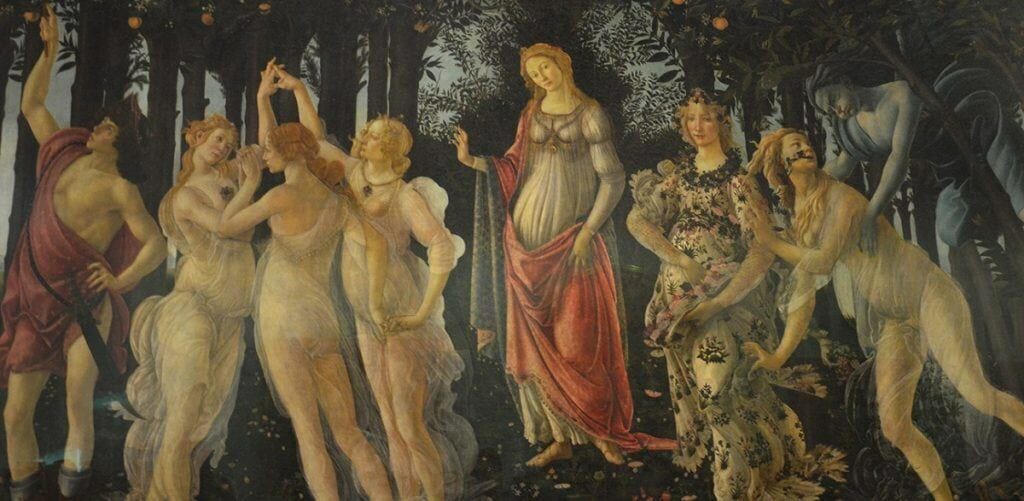
Alessandro di Mariano di Vanni Filipepi is one of the foremost figures of the early Italian Renaissance and his works and painting style likely inspired countless masterful artists that would come after him.
He is more commonly known as Sandro Botticelli and was built-in in Italy around 1445.
This nickname was derived from i that was bestowed on his older brother who had a rotund stature, prompting others to refer to him as a "barrell" or "Botticello" with the artist becoming known as Botticelli, or "little barrel."
Botticelli'south painting style was i that more or less defined the early Italian Renaissance era. He created figures in a way that was much more intimate that other artists at the fourth dimension typically depicted their subjects.
One of Botticelli'southward most famous paintings is titled Primavera, which means "Spring" in Italian. Critics and historians believe that his work was finished sometime in the belatedly 1470'south or early on 1480's.
The painting depicts six female figures and 2 males, along with a pocket-size cupid that can exist seen hovering above what many critics believe to be the effigy of Venus.
The whole painting shows move from left to right and signifies the changes that certain figures get through, according to Roman legend. It is widely recognized as one of the most iconic works centering around the spring season.
ii. Springtime – Claude Monet
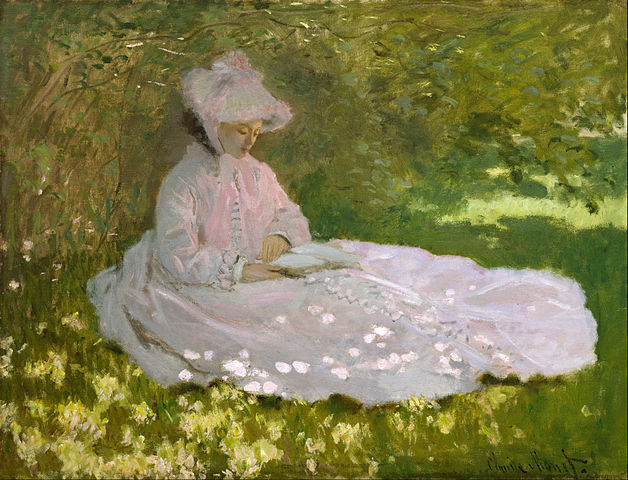
Claude Monet is i of the most highly-regarded figures from the Impressionist movement that took identify in the 19th century. The French creative person was built-in in Paris in 1840 during a time when the city was a humming hub of artistic expression.
Effectually the age of 30, Monet began to display a passion for living and spending fourth dimension in rural areas instead of the urban center that so many other artists were clamoring to get to.
It was at this fourth dimension when Monet created a masterpiece that many critics say is a beautiful representation of bound and its true meaning. Finished in 1872, the work was only titled Springtime, but it is also known as The Reader since Monet himself bestowed information technology with the title of Woman Reading when it was first exhibited in 1876.
The painting depicts Monet'southward wife, Camilla sitting under a canopy of lilacs reading a volume, the flowers around her teeming with life.
This piece of work was done shortly after Monet moved his family from Paris to a pocket-sized village to the northwest called Argenteuil. There, he would draw inspiration to create a number of other works that featured natural settings full of spring beauty.
3. Springtime – Pierre Auguste Cot
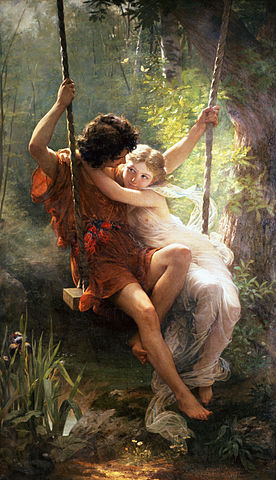
During the time in which Monet and other artists were enthralled in the Impressionist move, others would piece of work in a unlike style that was known as Academic Classicism.
Pierre Auguste Cot was one such artist who is known to accept created a number of incredible masterpieces during his career.
One of Cot's most well-known paintings is besides titled Springtime and was completed in 1873. First exhibited at the Paris salon, Cot'due south painting received high praise from the critics of the time for its intense item and underlying bulletin.
The painting portrays two young lovers sitting on a swing in a lush forest. The young girl is gazing lovingly into the young man'due south eyes every bit she clings to him.
The painting is one of the most famous that includes whatsoever reference to the spring season and is known for its articulate indication that leap is the season of love.
4. Almond Blossoms – Vincent van Gogh
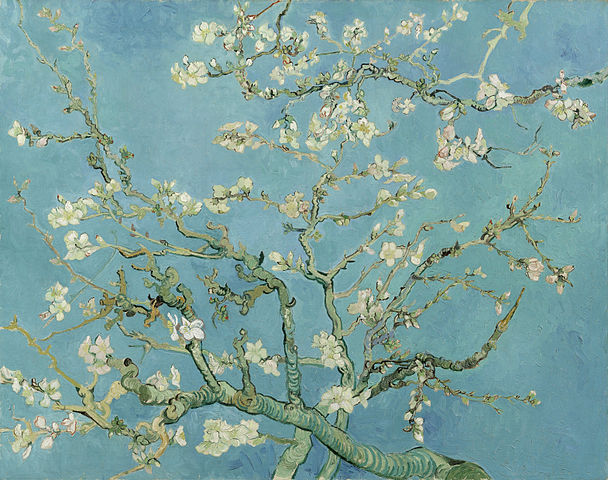
Vincent van Gogh was one of the most achieved artists in history and had a reputation for painting natural scenes that were full of vibrant beauty and color.
Van Gogh was a deeply-troubled artist who spent a big portion of his tragically short life in asylums and sanatoriums effectually French republic.
He painted numerous works depicting blossoming trees as they represented promise and a rebirth of sorts—possibly the notion of hope that he looked to at times when he experienced especially dark states of consciousness due to his constant bout with mental disease.
This i is titled Almond Blossoms and was done in 1890 while van Gogh was living in Arles, which is a quaint coastal city on the southern coast of France.
This particular painting was role of a serial and was created equally a celebration souvenir to van Gogh'southward brother, Theo and his sister-in-law, Jo as they were bringing a kid into the world that would be named Vincent, after the artist himself.
The painting is very simple in composition as information technology features a sprawling tree branch set confronting a bright, blue sky. The light-pink blossoms are bright, as are the branches of the almond tree.
Although it is ane of the bottom-known van Gogh paintings, it is one of the all-time representations of his interest in Japanese woodblock paintings.
5. Le Boulevard de Montmartre, Matinée de Printemps – Camille Pissarro
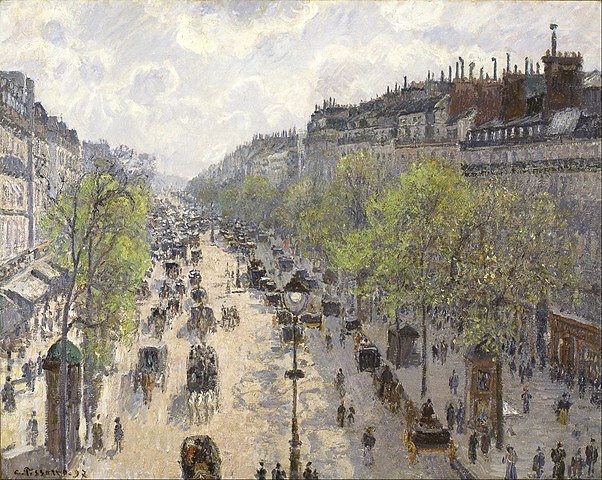
Camille Pissaro was another brilliant Impressionist artist who lived in Paris during the mid-to-belatedly 19th century and shaped the overall motility through his unique manner of painting that Pierre-Auguste Renoir described every bit "revolutionary."
Pissarro normally painted scenes from in and effectually Paris or rural parts of France to depict different views of life for the people of French republic during the 19th century.
I of Pissarro's famous cityscape paintings is titled Le Boulevard de Montmartre, Matinée de Printemps. This 1987 painting captures a busy solar day on the popular boulevard that was frequented past people from all walks of life.
Pissarro was non the only artist to pigment a scene from this item part of Paris equally many others have depicted the Boulevard de Montmartre from it's heyday during the late 1800's.
The painting is especially famous for Pissarro's depiction of the humming street and the bright sunlight beaming down onto it. This piece is one of the highest-priced auctions from any of Pissarro'southward remaining works.
6. Spring – Lawrence Alma-Tadema
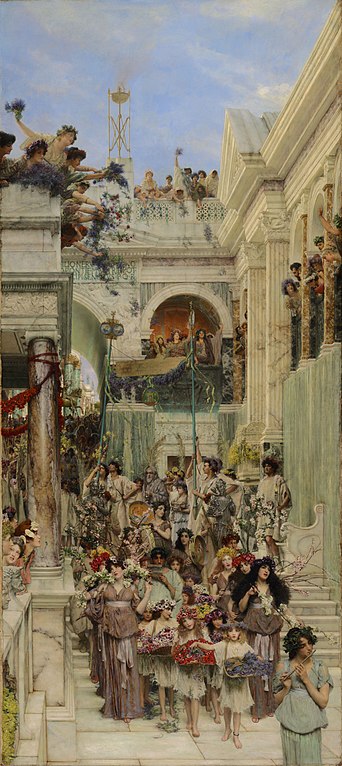
Lawrence Alma-Tadema is another prominent artist from the Academic Classicism movement that occurred during the same timeframe as the Impressionist era.
The Dutch artist was built-in in the netherlands in 1836, but would subsequently become a British denizen and travel across much of Europe during his career.
Critics and scholars debate as to what Alma-Tadema's almost famous painting is, but many bespeak to a work that revolves around the spring season—specifically a scene from the ancient Roman empire and a celebration of spring. The work is only titled Leap and was completed in 1894 in the latter years of the artist's career.
It is known for the lively procession of figures, mostly women and children, who are parading through the city in what is an apparent festival occasion marking the jump flavour.
This painting is non actually done equally an authentic representation of any Roman street or structure every bit Alma-Tadema appears to accept combined a number of different prominent landmarks into this ane single piece of work.
7. Spring – Giuseppe Arcimboldo
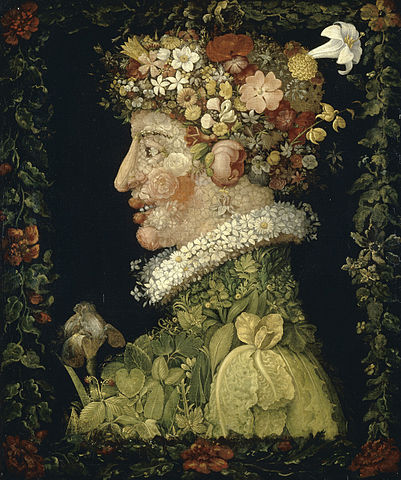
Giuseppe Arcimboldo is 1 of the more remarkably ambiguous figures from the Italian Renaissance era. The artist was born in Italy in 1527, just his works clearly practice not align with any other painter from the Renaissance move.
He instead created baroque, yet well-composed paintings that many critics and scholars still fence nigh today as to whether they were the product of an especially creative heed, or someone teetering on the brink of madness.
Arcimboldo created a series of works titled The Four Seasons betwixt 1563 and 1573. I of these works is titled Spring and is considered 1 of the most unique, and iconic depictions of the flavour in history. This peculiar work depicts the spring season, and each of the other three, as a seated individual in a portrait style.
Spring is a human figure that is fabricated upwards of a collection of flowers and other vegetation that was known to have existed and characterized the season in Italy during the 16th century.
8. Angling in Spring, the Pont de Clichy (Asnires) – Vincent van Gogh
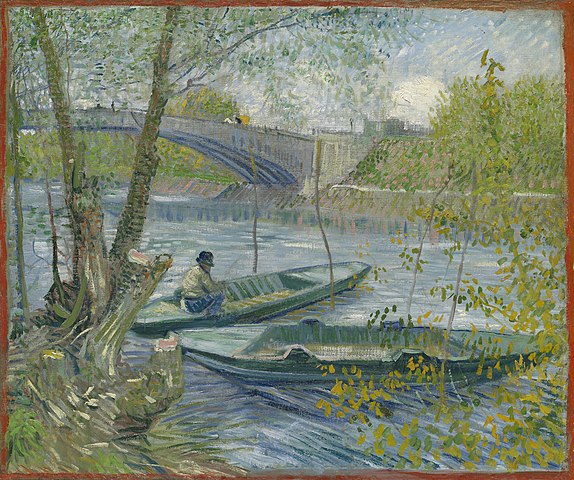
Van Gogh is known to accept had a special affinity for the outdoors as the vast majority of his works center around natural settings that involve ponds or flowers and trees. One of his other, slightly lesser-known, works features a scene from the Seine River that represents the exuberant and cheerful side of the spring season.
Painted in 1887, this work is titled Line-fishing in Spring, the Pont de Clichy (Asnires). It depicts a man seated in a pocket-size gunkhole, fishing with a rod and reel beneath a tree. A bridge is seen in the groundwork while the entire work is encapsulated with flowery vegetation of low-cal orange and green colors.
Besides Read: Famous Summer Paintings
Many critics bespeak to this painting every bit a very natural and quintessential representation of an Impressionist work from one of the greatest painters in history.
9. Leap Blossoms, Montclair, New Jersey – George Inness
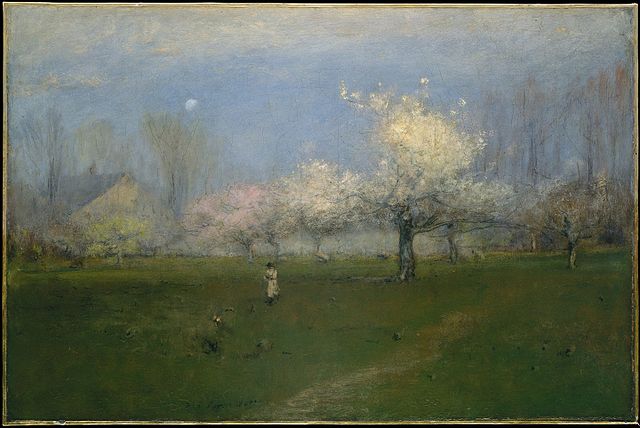
George Inness is remembered as an exceptional artist of the 19th century who was neither fully committed to Impressionism or Realism, just produced a number of incredible landscape paintings during his career.
He was built-in in New York in 1825 and his paintings are usually characterized by a complex scene that features variable degrees of sunlight or tumultuous weather conditions.
One of his greatest works is titled Leap Blossoms, Montclair, New Jersey and was completed in 1891 at the end of his life. This painting has many Impressionist characteristics and depicts a calm setting in a small field that's dotted with blossoming pink and white copse with a house in the background.
10. The Small Meadows in Bound –Alfred Sisley
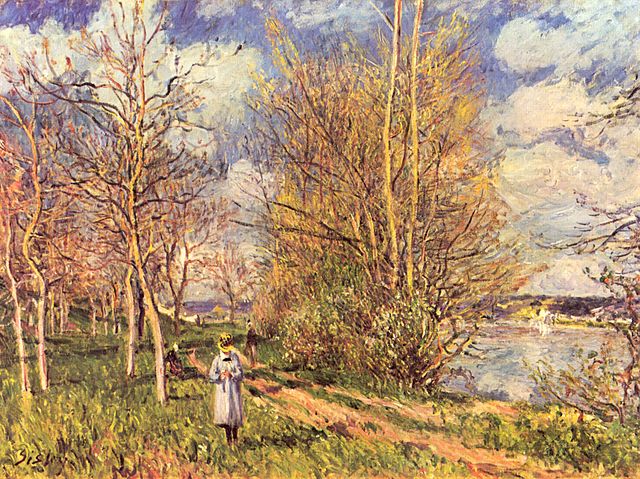
Alfred Sisley was another painter that lived during the 1800's and was an accomplished Impressionist painter that hailed from Paris and spent almost of his life in France. Critics who have studied his work can typically identify a Sisley painting as he had a very distinct, nevertheless unchanging fashion throughout the entirety of his career.
1 of the most celebrated works he produced was titled The Small Meadows in Spring, By and was finished in 1881. This work features a beautifully-sunny setting that depicts a woman strolling alongside a path that hugs the banks of the Seine River.
The entire painting is illuminated with brilliant furnishings of the morning sun and many scholar and historians believe the young woman in this painting is Sisley's own daughter, who would have been nearly 12 years old at the time it was painted
Source: https://www.artst.org/spring-paintings/
0 Response to "10 Most Famous Spring Paintings"
Post a Comment